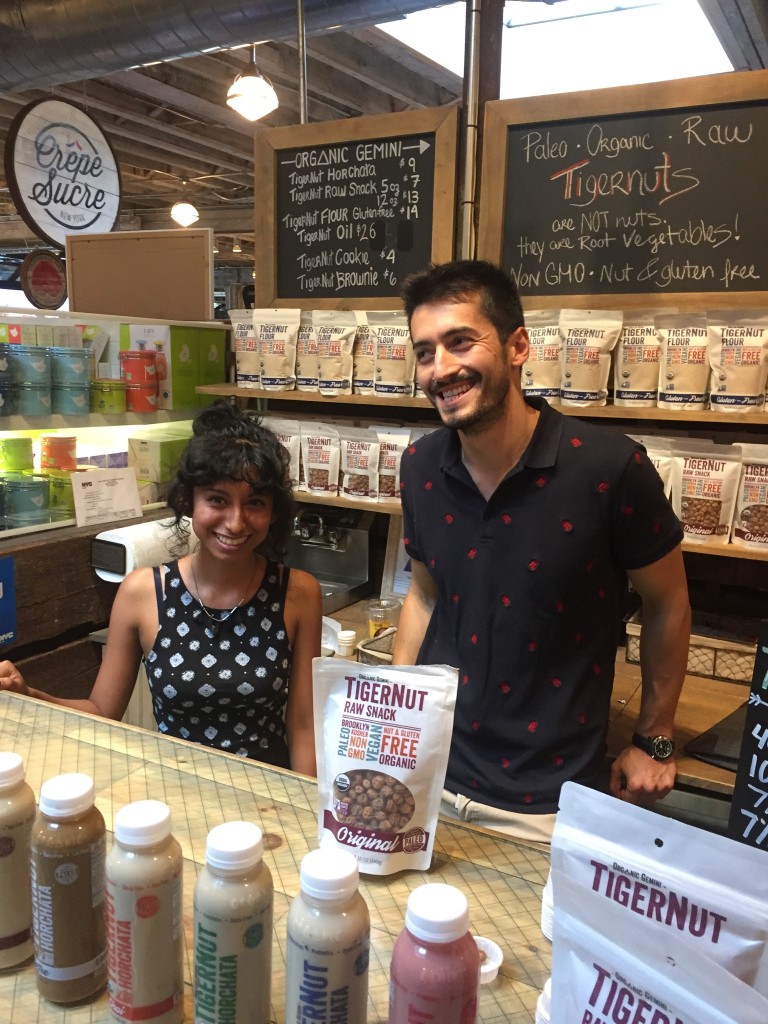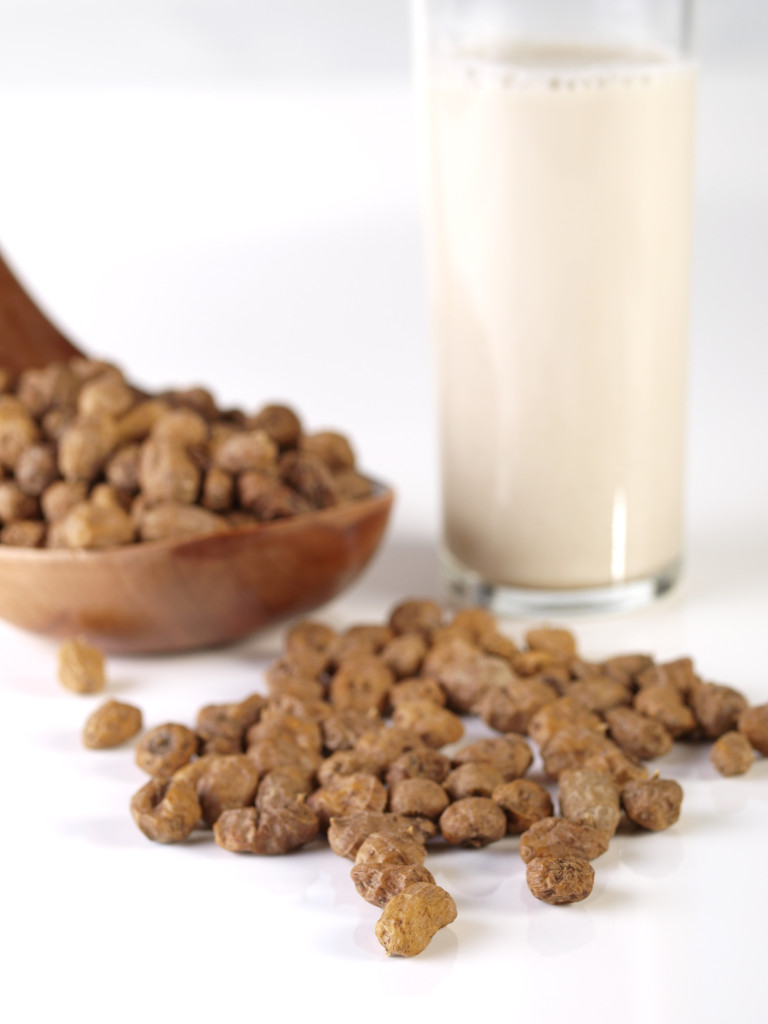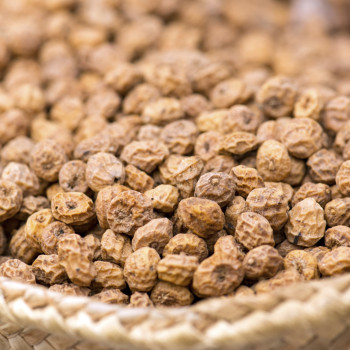Tiger nuts seem to be the latest contender in nutrient-rich fad foods, but they have nothing to do with tigers or nuts. Devotees say they are a superfood and they’re suddenly everywhere, in dried form and in horchata, a milky drink made from them. So to learn more, Brendan met with George Papanastasatos, co-founder of tiger nut distributor Organic Gemini, at one of his New York shops.
“If tiger nuts aren’t nuts,” Brendan asked George, “then what are they?”

George Papanastasatos: Well said, not a nut. Tiger nut – despite the name – is not a nut, has nothing to do with tigers. It’s a small root that is indigenous to Africa, and Mediterranean.
Brendan Francis Newnam: So, they’re related to a potato?
George Papanastasatos: Potato, any other… like carrots, beets.
Brendan Francis Newnam: So why is it called a tiger nut then?
George Papanastasatos: Good question. I don’t know, for the same reason that a peanut is called a peanut.
Brendan Francis Newnam: Even though they’re secretly legumes?
George Papanastasatos: That’s right!

Brendan Francis Newnam: How many tiger nut jokes are made… how many name jokes are made, a day, in front of you?
George Papanastasatos: Well, every time I’m trying to explain the tiger nut, everybody’s like, “Who holds the tiger?” So, there are a lot of jokes.
Brendan Francis Newnam: They’re called tiger nuts, right, because they have stripes? Yeah, they kinda do have stripes.
George Papanastasatos: Yeah. Try this one [hands Brendan a raw tiger nut].
Brendan Francis Newnam: So how have you prepared this one? I’m gonna taste this raw one.
George Papanastasatos: This hasn’t been processed. This has been harvested, washed, and then sun dried.
Brendan Francis Newnam: And, it looks like a dry… like if you bought garbonzo beans or something.
George Papanastasatos: Right. When it’s fully hydrated it’s rounded it looks like a little, like a small ball.
Brendan Francis Newnam: All right I’m gonna try one [tastes raw tiger nut]. It’s like a walnut but a slightly sweeter.
George Papanastasatos: Correct.
Brendan Francis Newnam: So, before it looks like this, what does it look like? Where do tiger nuts come from?
George Papanastasatos: It’s a long grass. In Africa it grows up 3 to 4 feet high. The same way you do potatoes: they take them off the soil, and then they let them dry for three months.
Brendan Francis Newnam: So, I’d never heard of tiger nuts until recently. What’s the history of this tuber?
George Papanastasatos: If you take it all the way back, it started in the Mesopotamia, which is like the Middle East…
Brendan Francis Newnam: And Egypt, right?
George Papanastasatos: And Egypt. Egyptians, we know for a fact, they cultivated tiger nuts. There are historical records that the Pharaohs enjoyed a very sacred elixir. Something close to what we’re making today, a horchata.

Brendan Francis Newnam: For people who don’t know, can you explain what horchata is generally? And then we’ll talk about how you make it here at Organic Gemini.
George Papanastasatos: Well, horchata started in Valencia, Spain, back in the 13th century. Legend has it that the king of Spain, James, exclaimed, “This is golden, darling” the first time he tried horchata.
Brendan Francis Newnam: “This is golden, darling.” That’s great.
George Papanastasatos: And that’s the name. For whoever speaks Spanish, “Oro” is gold and “Chata” in Catalan means darling. So the two words combined makes horchata.*
Brendan Francis Newnam: So, it’s like an exclamation?
George Papanastasatos: Yeah, that’s what legend has it so.
Brendan Francis Newnam: All right, well we can accept the legend if it’s a good story.
George Papanastasatos: Then, we know from 13th century, we have the people in Valencia making horchata. Then the same people that immigrate from Spain to South America, knew of horchata, had no access to tiger nuts, and they started making it from rice, nuts, seeds. That’s why now modern horchata, it’s known from rice.
Brendan Francis Newnam: Yeah, modern horchata is usually rice-based. You can find it in Mexican restaurants and South American restaurants, and it’s usually kind of sweet.
George Papanastasatos: That’s our main challenge, trying to educate people.
The original horchata is not made from rice, but comes from tiger nuts. And it has so much more nutritional value.It’s not made from sugar, doesn’t use any sugar, especially not in our recipe.
Brendan Francis Newnam: So how do you make it? How do you make your unsweetened, classic, tiger nut horchata?
George Papanastasatos: Well, we treat tiger nuts as any in other nut, and we soak them into water, then we cold press them, and that’s about it. We’re put it into bottles, and that’s our unsweetened horchata.
Brendan Francis Newnam: I’m looking at some now, it has like a milky quality to it.
George Papanastasatos: It’s pretty milky. It’s pretty sweet, super creamy… if you wanna try it.
Brendan Francis Newnam: All right I’m gonna try it right now here. And it’s, it’s thin, it’s not very viscous. It’s like, kinda like a lighter milk [tries horchata]. It’s tasty, it’s not super sweet. It has a coconut undertone.
George Papanastasatos: Correct. You see, it has some coconut, others things [it] has: almond, vanilla…
Brendan Francis Newnam: And so, why would I wanna drink this? I have a lot of options when I go to the store. I prefer tea, wine, and martinis. Why would I wanna incorporate horchata?
George Papanastasatos: Well that won’t give you any of that [laughs]. But here’s what you get: you get a lot of iron, you get calcium — you get as much calcium as dairy — and then you also get potassium. It has more potassium than coconut water.
And in addition to that, it has a very unique fiber content. Oxford University published a study about a year ago, showing that tiger nuts were the primary source of food for our paleo ancestors.
Brendan Francis Newnam: For our paleo ancestors. And, as you know, the paleo diet is very popular, which means people who eat raw foods, and whole foods.
George Papanastasatos: Correct. And then they actually came to the conclusion why our ancestors intuitively love this food.
Tiger nut has the same micro-nutrient profile as red meat, and liver, so–
Brendan Francis Newnam: Wait, OK, so tiger nuts have the same micro-nutrient profile of red meat and liver?
George Papanastasatos: When you look at the rest of it, in fat, carbs, iron and calcium, it’s stands against red meat, liver, or even breast milk.
Brendan Francis Newnam: Whoa, so this not only will this replace liver and onions, it’ll replace mothers?
George Papanastasatos: Sort of.
Brendan Francis Newnam: What about liver horchata? Same, same nutritional value.
George Papanastasatos: That would make me vomit [laughs].
*[Ed note: Much as we love the legend of royal horchata, the name more likely derives the Latin word hordeata, which means “made from barley.”]


